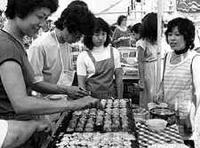Japanese
JAPANESE immigration to BC began in 1877 with the arrival of Manzo Nagano, a sailor who jumped ship in NEW WESTMINSTER. Nagano, who later owned a store and hotel in VICTORIA, was followed by a small number of mostly male Japanese sojourners who remained temporarily. In 1891, for example, a group of 100 labourers came to work in the COAL mines at CUMBERLAND. In 1895 Japanese residents, whether or not they were Canadian citizens, were denied the provincial vote and, as a result, the federal and municipal vote as well. They were also denied the right to hold public office and to take jobs in most professions. This was followed by other discriminatory legislation aimed at stemming the inflow of immigrants, though the federal government felt obliged to disallow most of it because it violated international agreements between Britain and Japan. By 1901 there were 4,600 Japanese living in BC, 97% of all Japanese in Canada. Many were single males who had intended to return home. When they could not, they turned to the picture-bride system of arranged marriages. They found work mainly in FISHING, MINING and the FOREST INDUSTRY, and in railway construction, where employers paid them less than other workers. In about 1914 many Japanese began moving onto farms in the FRASER VALLEY around MISSION and HANEY and in the OKANAGAN VALLEY, where they grew BERRIES and TREE FRUITS (see also AGRICULTURE).
Anti-Asian sentiment in the population boiled over in Sept 1907 when a mob rampaged through Japanese and CHINESE quarters in VANCOUVER (see ASIATIC EXCLUSION LEAGUE). Japan then agreed to restrict emigration to BC and the number of new arrivals dropped sharply. Those who did come were mainly women and children joining their men, initiating what has been called the "family-building phase" of Japanese immigration. The growth of the community was dealt a blow in 1928 when Japan agreed to restrict emigration to Canada to 150 individuals annually. Also during the 1920s Japanese fishers were increasingly excluded from the coastal fishery by government regulation. The provincial franchise was extended to Japanese Canadian veterans of WWI in 1931, but the rest of the community remained excluded from government.
Despite the discrimination, the first generation of Japanese in Canada (the Issei) established themselves in the fishing industry, on farms in the Lower Mainland and the Fraser Valley and in the main urban neighbourhood around Powell St in Vancouver, known as Nihonjinmachi—"Japanese town," or "Little Tokyo." The second, Canadian-born generation, the Nisei, accounted for over half the people of Japanese ancestry in BC by WWII. But discrimination peaked during the war, when some 22,000 people of Japanese ancestry were removed from coastal BC and relocated to Interior camps and to other provinces east of the Rocky Mts (see JAPANESE, RELOCATION OF). By 1947 the number of people of Japanese descent living in BC was reduced to 6,776. For the first time, more people of Japanese ancestry lived in the rest of Canada than in BC. Not until 1949 were evacuees allowed to return to the coast.
Japanese Canadians received the federal franchise in June 1948 (effective Apr 1949) and the provincial vote in Mar 1949; governments had recognized at last that they were citizens like any others. Still, restrictions on immigration to Canada from Japan were not all lifted until 1967. Since that time only a comparatively small number of Japanese have immigrated to BC. A third generation of Japanese Canadians—the Sansei, born since the war—encountered less discrimination than earlier generations and moved more easily into professions and jobs once closed to them. Many married non-Japanese people; a substantial number achieved positions of influence and authority. In 1988 the federal government formally apologized and compensated the Japanese Canadian community for the WWII relocation policy. At the 2001 census there were 37,390 people of Japanese origin living in BC. Most live in Vancouver, and while the large central Powell St community was never restored, a major Japanese Canadian cultural event, the Powell Street Festival, is held the first weekend of Aug each year. There is a significant Japanese Canadian population in STEVESTON, where a Japanese Canadian Cultural Centre opened in 1992. Prominent members of the Japanese Canadian community in BC have included the environmentalist David SUZUKI, the writers Roy MIKI, Joy KOGAWA and Roy KIYOOKA, the artist Takao TANABE, the photographer Tamio Wakayama and the architect Raymond Moriyama.
Readings: Ken Adachi, The Enemy that Never Was: A History of the Japanese Canadians, 1976; Roy Miki, Redress: Inside the Japanese Canadian Call for Justice, 2004.

